You might have heard about Ehomaki before or you may have already had a chance to make and eat it. In this article, not only will we explain about Setsubun and Ehomaki in general, but also the things you may not already know about them.
Read on to find out what else you eat at Setsubun besides Ehomaki, what type of luck each traditional Ehomaki filling represents, discover some modern day versions of Ehomaki with a twist, and the easiest way to make Ehomaki at home together with practical tips on how to make and eat it.
Setsubun and Things to Do
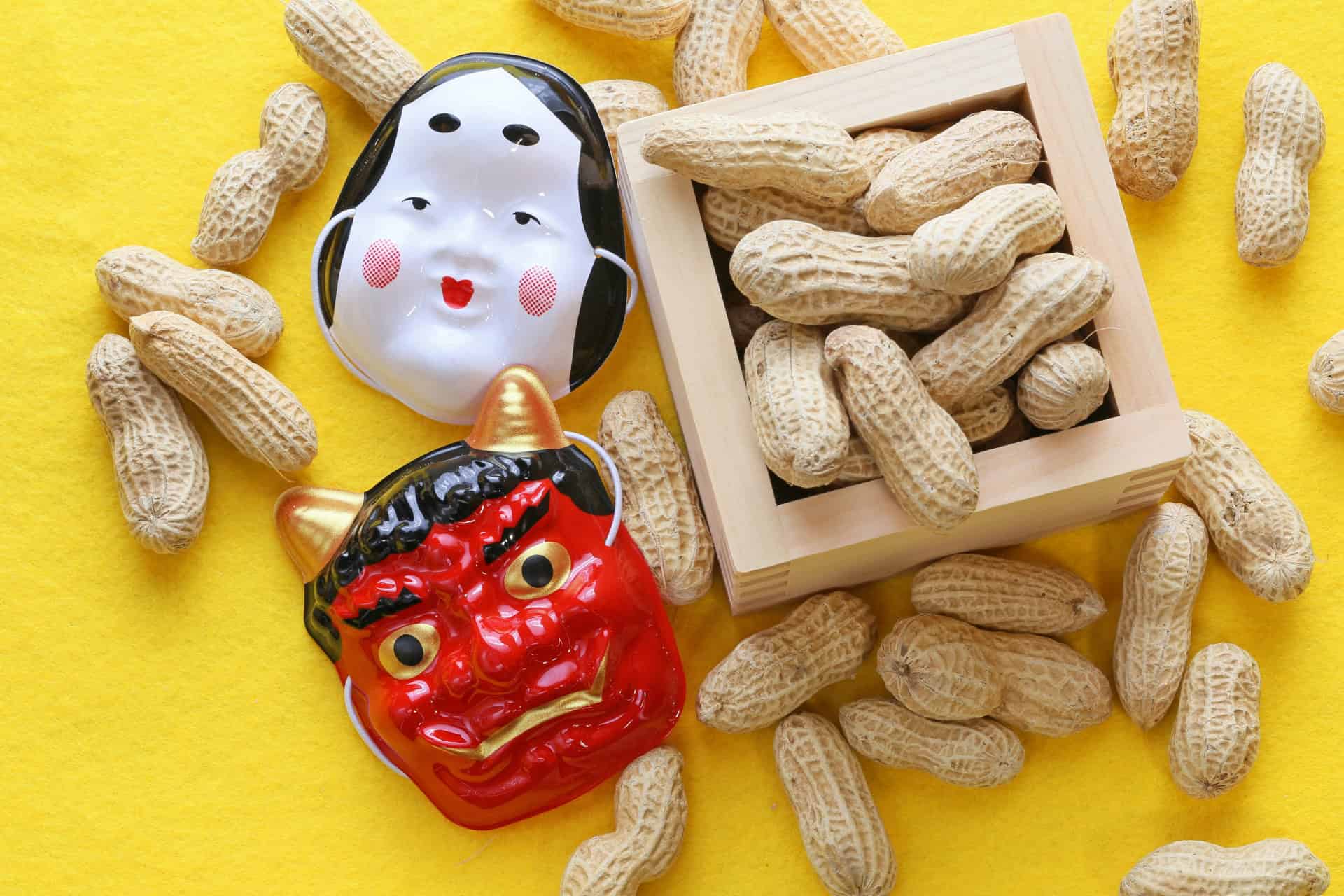
Setsubun, (written as 節分 in Japanese), means ‘seasonal division’, marking the transition between winter and spring. Setsubun Day is the last day of winter, and the next day called (立春 Risshun) is the first day of spring. The day of Setsubun falls between February 2nd and February 4th depending on the year.
In 2025, Setsubun is on February 2nd. Setsubun is a special day and celebrated not only at home but also other places including shrines and temples across Japan as it’s one of the important events in Japanese culture due to it being considered as the last day of the year on the old Japanese lunar calendar.

What is Mamemaki (豆まき)? This is a fun activity to do at Setsubun where you throw roasted soybeans or peanuts in shell while chanting “Oniwa Soto, Fukuwa Uchi”ーOut with Evil, In with Fortune! The act is believed to get rid of evil spirits and invite good fortune as it helps to cleanse your home or the space you’re in by taking out any negativeness. In this way, you can start fresh and welcome good luck for the year ahead.
Also, eating roasted soybeans for your age plus one more soybean is believed to bring good things for the coming year. Other things to eat at Setsubun include Ehomaki and Soba buckwheat noodlesーthe Setsubun version of Toshikoshi Soba (New Year’s Eve noodles) as Setsubun is New Year’s Eve on the old Japanese lunar calendar.
Ehomaki and the lucky direction for 2025

Ehomaki (恵方巻), often translated as Lucky Direction Sushi Roll or Prosperity Roll, is a special kind of Futomaki (thick sushi roll) that many people in Japan eat at Setsubun. You’re supposed to eat one whole sushi roll while facing the lucky direction of the year in silence to fulfill your wishes for a better and successful year ahead.
The year’s lucky direction depends on the year. For 2025, it’s the West-Southwest. You can easily find this info online, but if you want to figure it out yourself, there’s a simple rule for it. If you’re interested, please check the FAQ section.
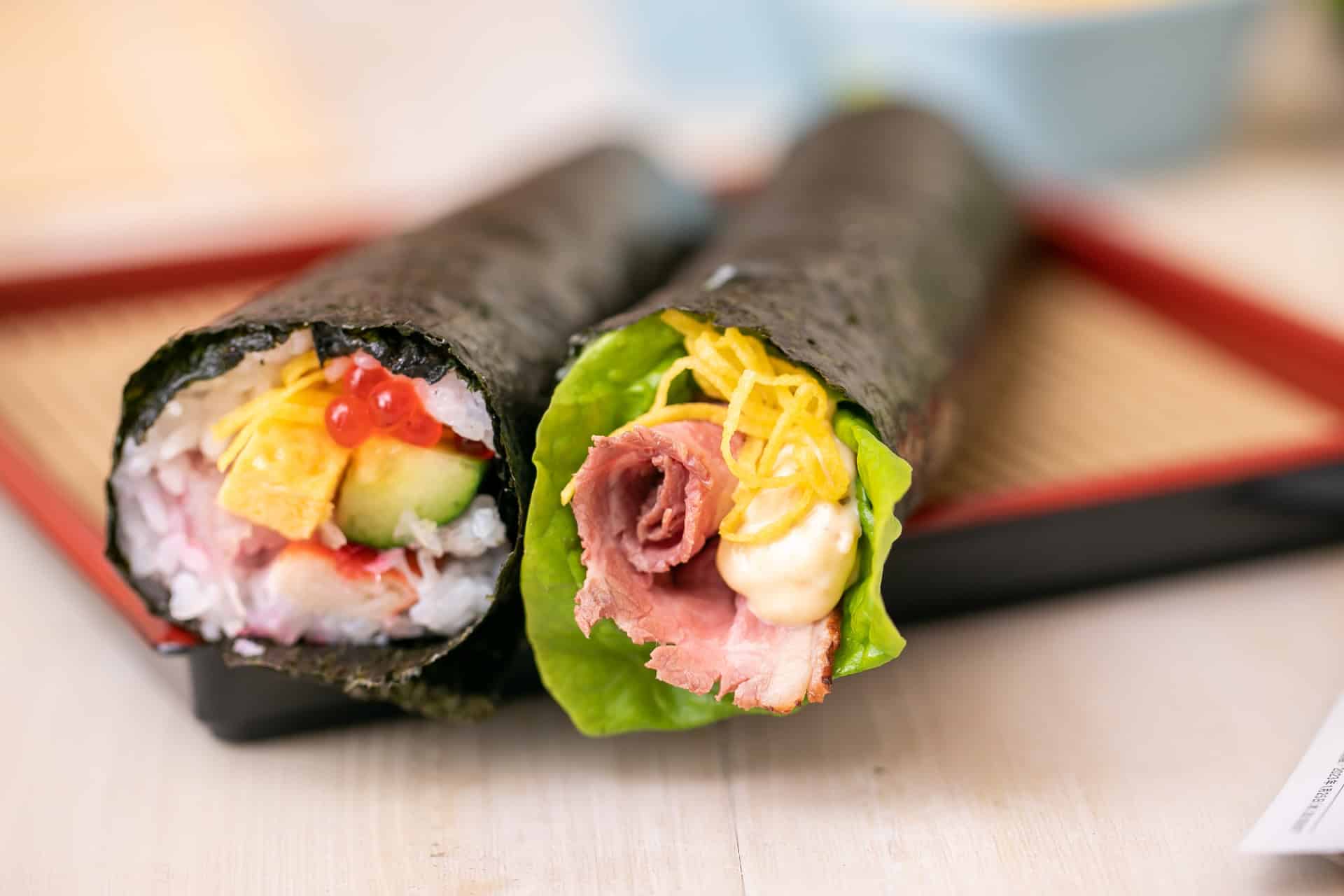
As for this Ehomaki-roll eating custom at Setsubun, how and where it started is unclear, however there’s a theory that it began as a regional tradition in the Kansai area which is in the western part of Japan, and in recent years it has definitely become more popular than ever.
Eating delicious Ehomaki goes beyond just enjoying a sushi roll as Japanese people see it as a way to bring in good fortune. This shows you how it combines tasty food with meaningful old customs and also makes it an important part of Setsubun celebrations which brings families and communities together for hopes of a better future ahead.
Traditional Ehomaki and Fillings
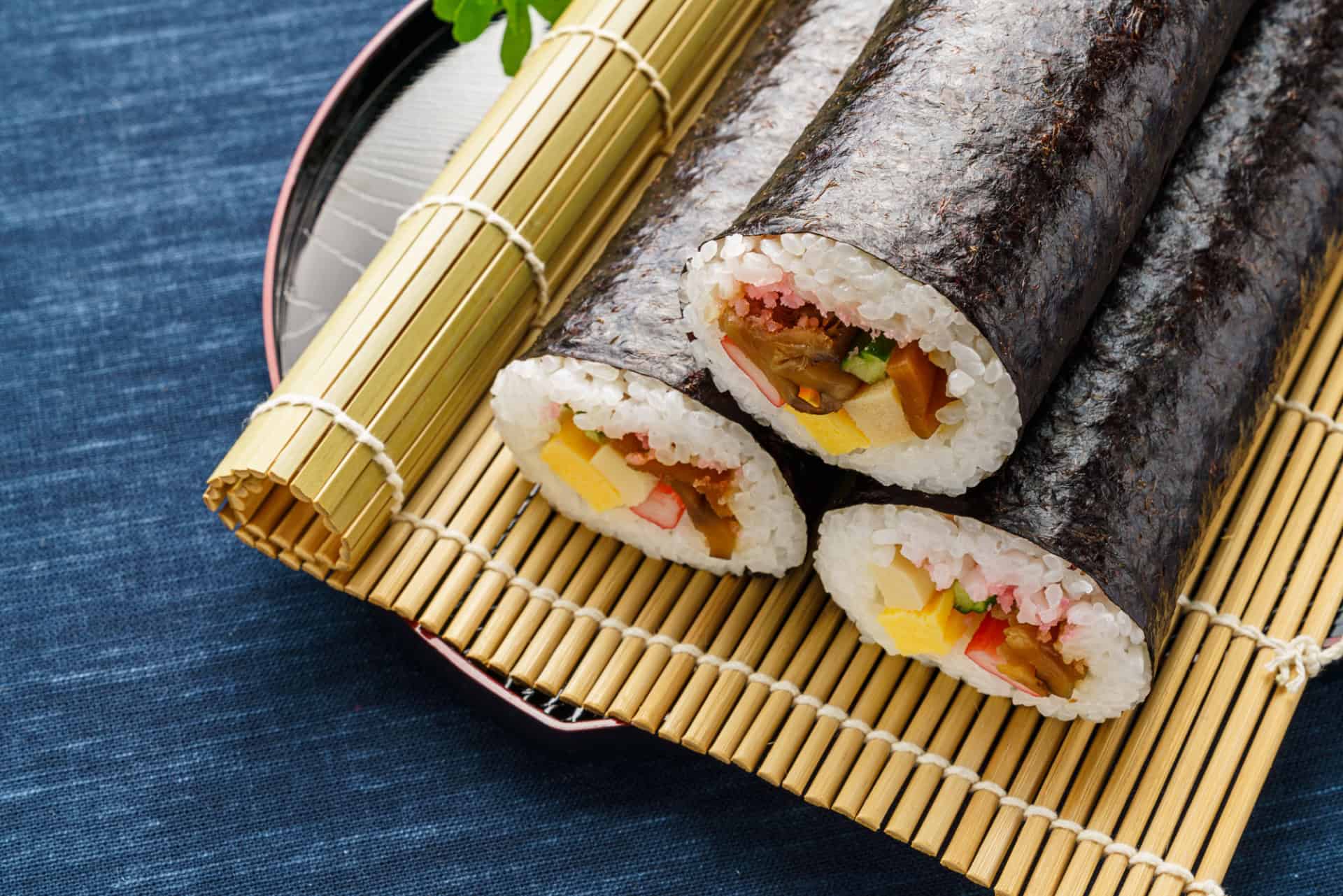
The traditional Ehomaki is made with seasoned sushi rice and seven fillings wrapped in Nori seaweed sheet. What makes it interesting is that each filling represents a type of good luck for the coming year, so these seven fillings are not only picked for their taste, but also for their good meanings.
The number of fillings, seven, is actually referring to Shichifukujin (七福神), the 7 lucky gods of Japan. Hence, Japanese people often try to select seven different fillings to make Ehomaki even if they are not using those traditional fillings. If you’re interested to know who those seven gods are, please see the FAQ section.
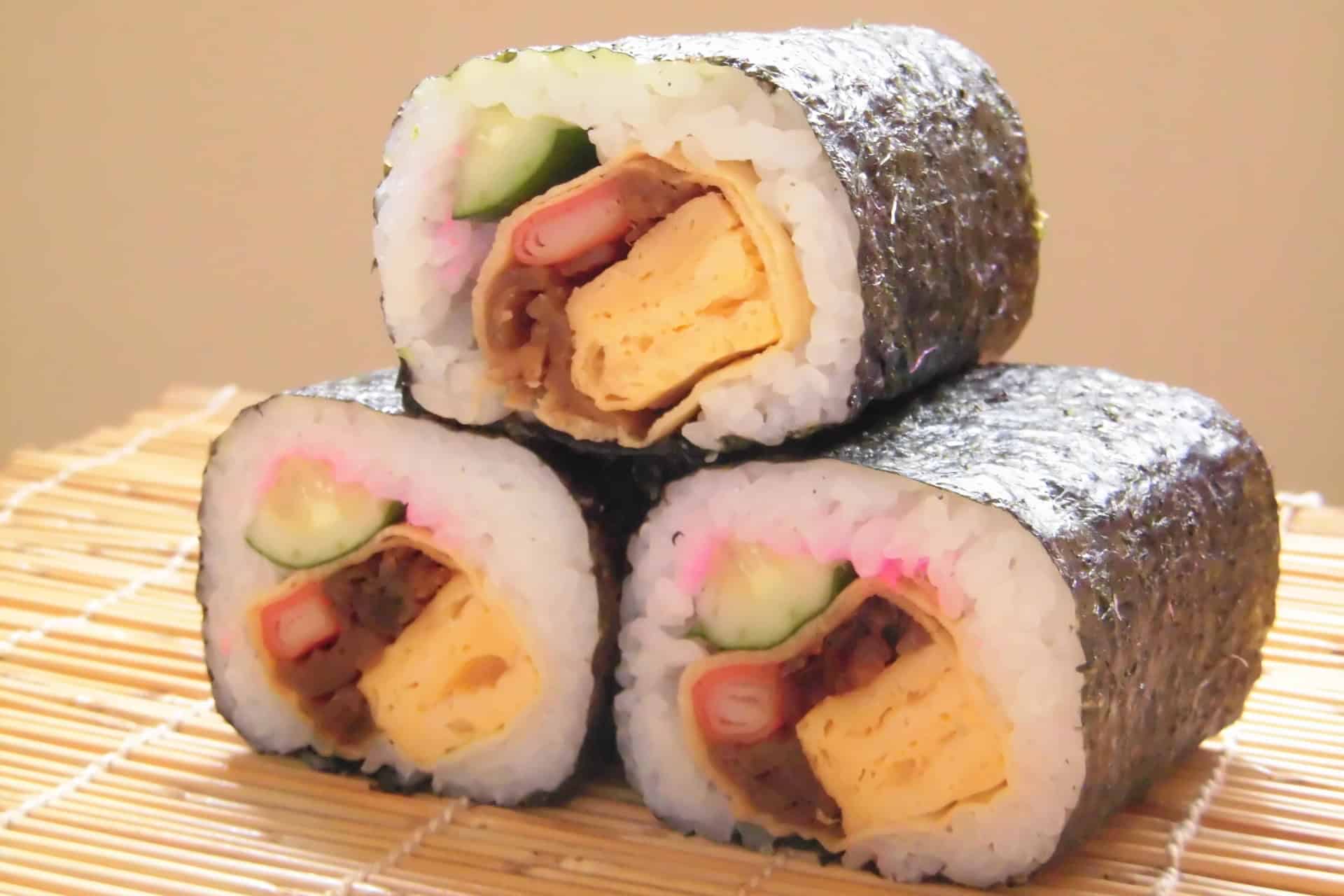
Traditional seven fillings with types of luck to bring for the year ahead are:
- Cucumber: which is considered to have many different benefits
- Eel: grilled with an eel kabayaki tare sauce ー for longevity and success
- Egg: seasoned and sweetened rolled omelette ー for money and wealth
- Kampyo (dried ground strips): cooked in a dashi broth, soy sauce and sugar ー for longevity
- Sakura-denbu (pink-colored sweetened fish flake): for happiness
- Shiitake mushrooms: simmered in a dashi broth, sugar and soy sauce ー for protection
- Shrimp: boiled or steamed ー for longevity and happiness
Modern Version of Ehomaki

Ehomaki can be made with different fillings depending on personal taste and the region of Japan since there is no specific rule for making it. You can make or buy a variety of Ehomaki rolls from department stores, supermarkets, sushi restaurants or even convenience stores in Japan. While traditional fillings have meanings and related to the seven Gods of Fortune, the modern versions go one step further creating many forms based on personal favourites and tastes.
Popular Ehomaki Sushi Rolls
- Seafood Roll: A gorgeous roll often filled with sashimi-grade tuna, salmon, squid, scallops, shrimp, salmon roe, cucumber and shiso oba
- California Roll: A popular roll in the US filled with avocado, cucumber, crab meat or imitation crab sticks, white sesame seeds and mayo
- Salad Roll: An easy and child-friendly roll filled with cucumber, lettuce, imitation crab sticks, and mayo often with tinned tuna as well
Modern Version of Filling Ideas

If you’re making Ehomaki yourself, you can be creative and choose whatever fillings you like, and how many fillings you want to add as this is absolutely the fun part. So enjoy making and eating your original Ehomaki which will hold your hopes for the coming year!
Ehomaki filling ideas
Here are some suggested filling ideas for making your Ehomaki:
1) Sashimi-grade tuna, salmon and/or sea bream 2) Fresh shrimp, scallop and/or salmon roe 3) Smoked salmon 4) Boiled shrimp 5) Grilled eel or sausage 6) Rolled omelet 7) Ham or Imitation crab sticks 8) Sliced cheese or cream cheese 9) Tinned tuna or salmon 10) Boiled or steamed carrots, spinach and/or asparagus 11) cooked shiitake mushrooms and/or kanpyo dried ground strips 12) Tofu 13) Avocado 14) Cucumber, lettuce and/or shiso oba 15) Roast beef, chicken or pork 16) Teriyaki chicken or salmon 17) Fried shrimp 18) Deep-fried chicken or pork cutlet 19) Sakura-denbu sweetened fish flake 20) Pickled takuan daikon radish or pickled plum paste
How to Eat Ehomaki the Correct Way
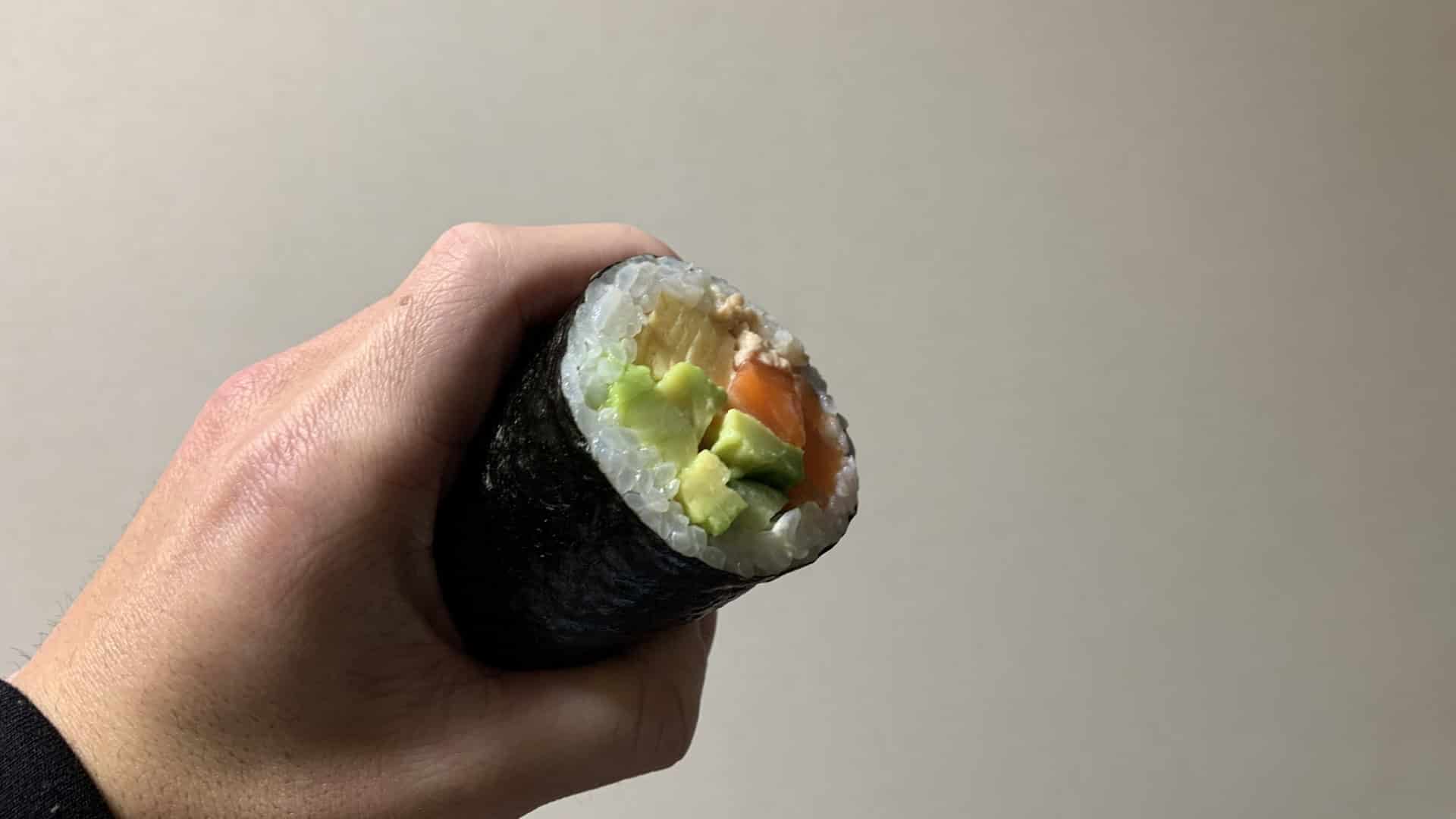
Here’s how to eat Ehomaki correctly in three steps.
- First, find the lucky direction for the year. For 2025, it’s west-southwest.
- Second, face this direction and hold the Ehomaki in your hand.
- Third, eat a whole Ehomaki without stopping and in silence while facing the direction and making a wish in your heart.
Tip 1: Avoid cutting/slicing Ehomaki, looking away or speaking while eating Ehomaki so as to make sure your good fortune does not get ‘broken’.
Tip 2: If you’re worried about not being able to eat it in one go, it’s better to make it a smaller size by cutting a nori sheet in half or a quarter before actually making it the normal way. Also consider making Temakizushi (手巻き寿司) ー hand-roll sushi as it’s smaller and easier to handle.
How to Make Ehomaki with Sushi Mat
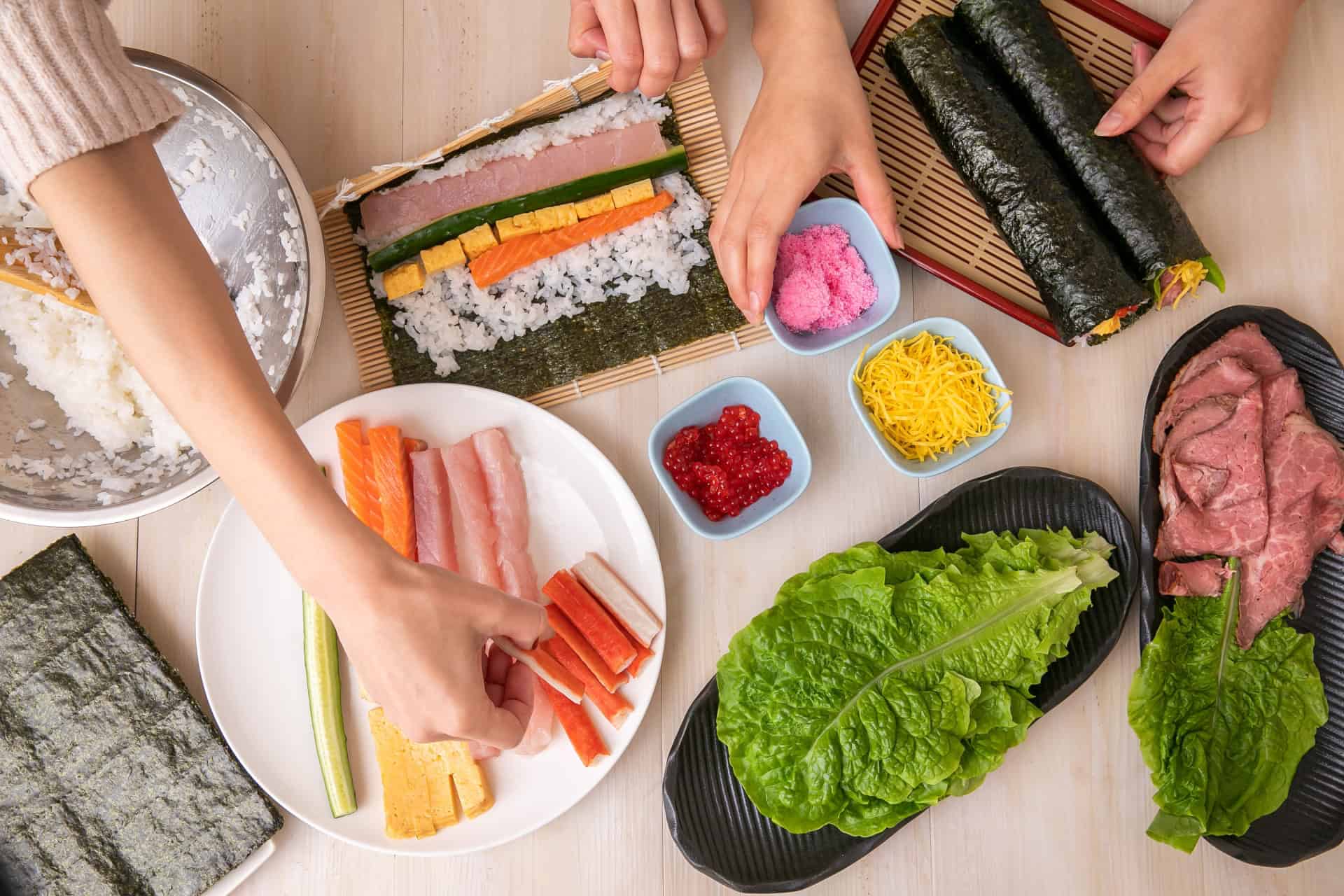
Making Ehomaki at home is easy and fun. You can make it the same way as you make makizushi sushi rolls―prepare your sushi rice and ingredients first and then set up your workstation and make sure you have all the tools and ingredients you need nearby before you start rolling. Then you can layer the ingredients on the nori sheet and use your bamboo sushi mat to roll and shape the sushi roll.
For more details on how to prepare and make makizushi, check our post of Makizushi; Makizushi Tools, Makizushi Ingredients, and Makizushi Step-By-Step Instructions.
Easiest Way to Make Ehomaki

The best thing about Ehomaki is you can virtually make it with anything you like as there’s no specific rule to follow. Traditionally, Ehomaki is supposed to be a Futomaki type of thick sushi roll, but now Japanese people make Temakizushi (手巻き寿司) hand-roll sushi or Hosomaki (細巻き) a slim version of sushi roll. So, you can always make a hand-roll sushi as it’s easier to make. What’s more some Japanese people are creating Ehomaki with a twist using bread instead of rice as well as substituting makisu sushi mat with cling film.
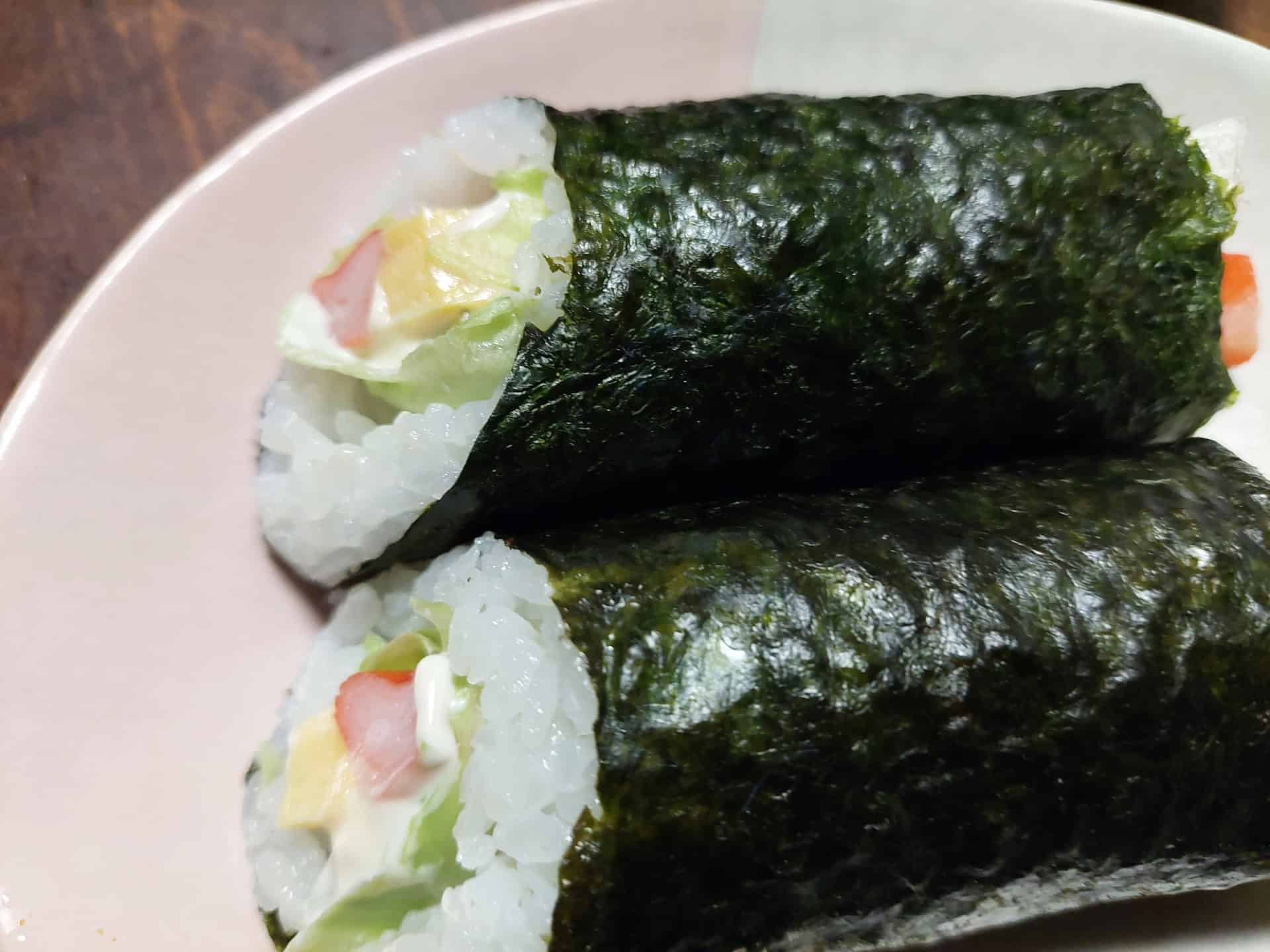
The easiest way to make Ehomaki is the simple salad roll with these fillings, cucumber and/or lettuces, imitation crab sticks and/or tinned tuna, with rolled omelet to include as an option.
Apart from the above fillings, all you need is a nori seaweed sheet, boiled rice, and mayo with a little bit of salt and pepper. You don’t need sushi vinegar or anything else. Those items should be available even from your local shops. As mentioned, if you don’t have time to cook rice, you can consider using bread instead. If a nori sheet isn’t available, you can try wrapping the fillings in a thin layer of egg omelette. For those who don’t have both rice and a nori sheet, an option might be to wrap the filings in a slice of flattened bread.
Where to buy Ehomaki Ingredients in London

You should be able to get most of the things you need in London to make Ehomaki such as nori seaweed sheets, sushi vinegar and other items at Japanese supermarkets or on Amazon.
If you’re wondering where to get fresh fish and seafood for sushi rolls, check our article of Sashimi in London – Where to buy the freshest fish in London as those places are great to get sashimi-grade fish and seafood.
FAQ
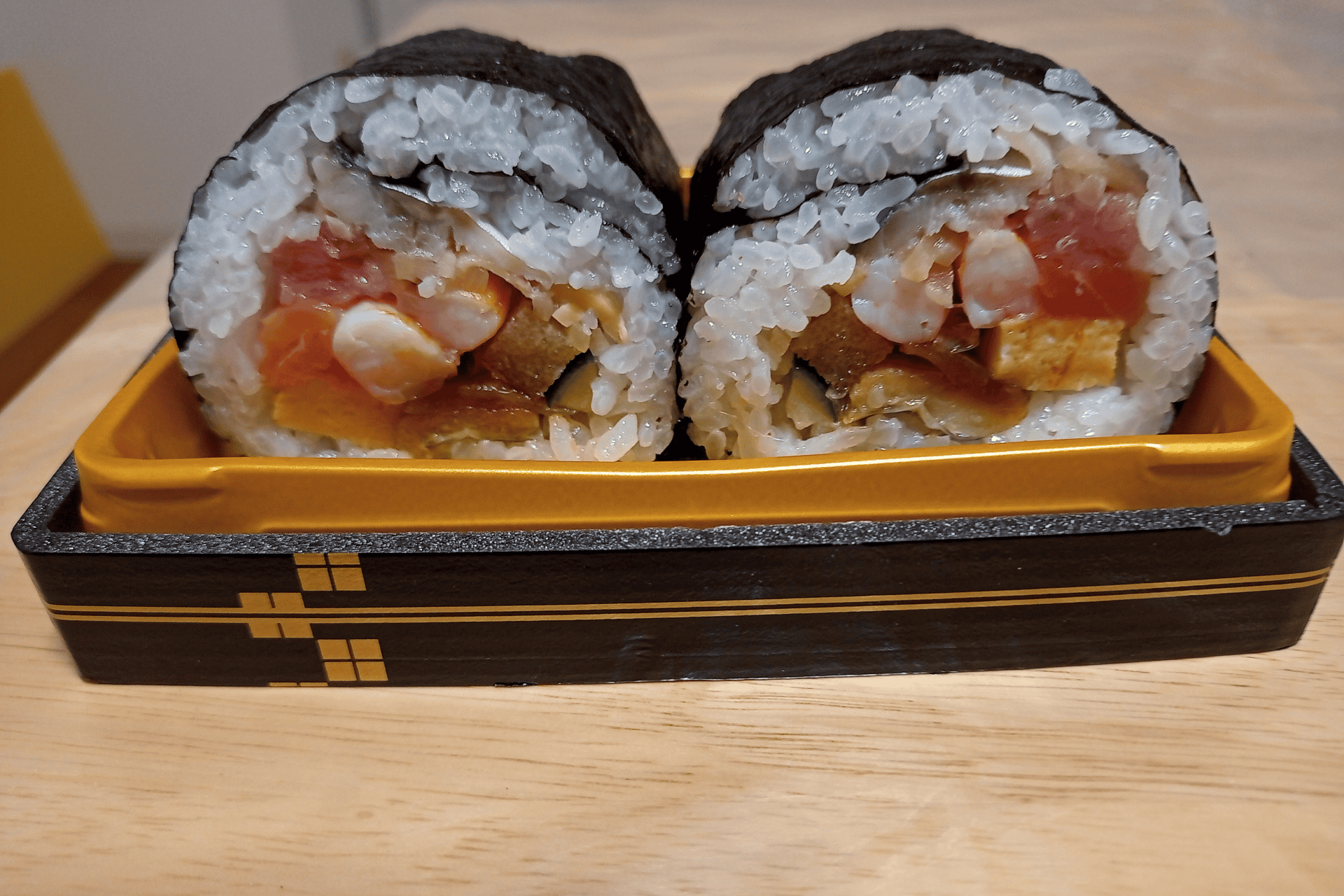
How do I find the lucky direction of the year?
You can get the info online quite easily, but basically there are four lucky directions and each direction is repeated on a 5-year cycle. If you like to figure it out yourself, here’s a quick reference; years ending with 0 or 5 is for west-southwest, years ending with 1, 3, 6, or 8 is for south-southeast, years ending with 2 or 7 is for north-northwest, and lastly years ending with 4 or 9 is for east-northeast.
What time should I eat Ehomaki sushi rolls?
There’s no rule as to what time to eat Ehomaki as long as you eat it on Setsubun Day, however, to welcome good luck, it might be a good idea you eat it after the house is cleansed by throwing roasted soybeans.
Do I have to stand to eat Ehomaki?
You can sit or stand depending on how you feel comfortable when eating it.
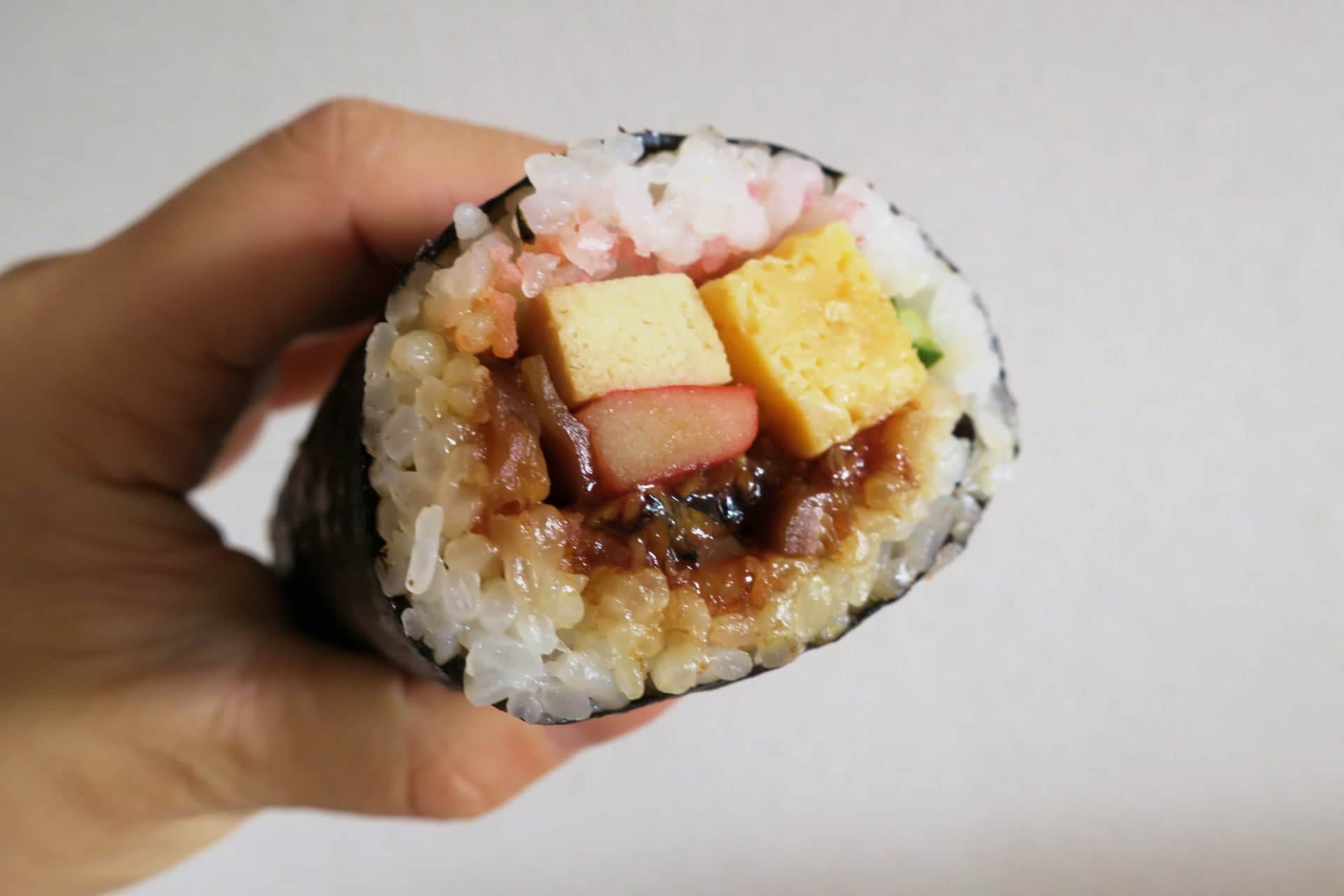
How many Ehomaki sushi rolls should I eat?
It’s one Ehomaki sushi roll per person, but you can eat more sushi rolls if you like.
Who are the Seven Lucky Gods of Japan?
The seven Gods of Fortune are: Ebisuten (恵比寿天 the God for trade & fishing), Daikokuten (大黒天 the God for trade & agriculture), Benzaiten (弁財天 the Goddess for arts & beauty), Bishamonten (毘沙門天 the God of war & protector), Hoteison (布袋尊 the God for happiness and luck), Fukurokuju (福禄寿 the God of wisdom, luck & longevity) and Jurojin (寿老人the God of longevity & good health).
For those who are interested in Japanese Food, check out more on our food section. If you’re looking for travel related posts, do explore our travel section. Or you can head to our Instagram account for posts of fantastic restaurants, festivals, and travel experiences.


